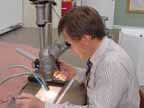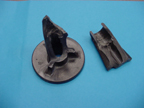| |
|
|
|
|
|
|
|
|
|
|
Static
Failures |
|
|
|
|
|
|
|
|
|
|
|
|
|
|
Static Failures occur
when machine components have been exposed to forces or leads that develop
stresses that exceed the strength of the material. When the stresses exceed
the yield strength the machine component is deformed permanently. When the
stresses exceed the ultimate strength the machine component fractures or
breaks. |
|
|
|
|
|
 |
|
|
Fatigue
Failures |
|
|
|
|
|
|
|
|
|
|
|
|
Fatigue Failures occur
when machine components have been exposed to the action of repeated or fluctuating
stresses where the maximum stresses are below the ultimate strength of the
material and frequently below the yield strength. A fatigue failure begins
with a small crack. As the material is repeatedly stressed, the crack propagates
into the machine component. Ultimately, the machine component fails suddenly.
Therefore, there are two areas that characterize a fatigue failure: an area
defined by the propagation of the crack and an area of sudden fracture.
|
|
|
|
|
|
|
|
|
 |
|
|
|
|
|
|
|
|
|
|
|
|
|
|
|
|
|
Creep
Failures |
|
|
|
|
|
|
|
|
|
|
|
 |
|
|
Creep failures occur
when a machine component is held for long periods of time below their yield
strength at temperatures which are sufficient to result in a continuing
elongation of the machine component. This may ultimately end in fracture
of the component. Materials vary a great amount in their ability to resist
the effects of temperature and stress. Some steel alloys have been developed
for use up to 2000°F. Lead and plastics will creep under stress at room
temperature. |
|
|
|
|
|
|
|
|
|
|
|
|
|
|
|
Wandling Engineering has the knowledge
and experience regarding the strength of machine elements and the application
of failure theories in the design of machine components. |
|
|
|
|
|
|
|
|
|
|
|
|
|
|
|
|
|
| |
|
|
|
|
|
|
|
| Copyright
© 2003, Wandling Engineering P.C., all rights reserved |
|
|
|
|





